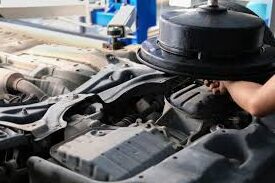Signs of a bad transmission
What is a transmission?
The transmission is a device that is connected to the back of the engine and sends the power from the engine to the drive wheels. An automobile engine runs at its best at a certain RPM (Revolutions Per Minute) range and it is the transmission’s job to make sure that the power is delivered to the wheels while keeping the engine within that range. It does this through various gear combinations. In first gear, the engine turns much faster in relation to the drive wheels, while in high gear the engine is loafing even though the car may be going in excess of 70 MPH. In addition to the various forward gears, a transmission also has a neutral position which disconnects the engine from the drive wheels, and reverse, which causes the drive wheels to turn in the opposite direction allowing you to back up. Finally, there is the Park position. In this position, a latch mechanism (not unlike a deadbolt lock on a door) is inserted into a slot in the output shaft to lock the drive wheels and keep them from turning, thereby preventing the vehicle from rolling.

Common signs of transmission problems
Your car’s transmission has run so well for so long, it can be a shock to hear you might have transmission problems. However, the earlier you spot the signs and get it looked at by a mechanic, the better off your car and your wallet will be.
To help you stay aware of your transmission and know when it’s time to get it checked, we’re sharing five of the most common signs of transmission problems. If you spot any of these clues, it’s time to set up a service appointment.
Leaking Fluid
A leaking transmission can cause a breakdown in short order. Leaking fluid could be a result of pan gasket damage, axle seal leaks, fluid lines and more. Any component of the system that has gaps or has been damaged could be the source of the leak. While leaking transmission fluid doesn’t mean you can’t drive the car, it’s not recommended to do so. You could cause permanent damage, worsening the original problem. Get leaking transmission fluid checked right away.
Burning Smell
Anytime you smell burning when it comes to your car you should pay attention. First, check the fluid. Automatic transmission fluid is typically bright red and smells slightly sweet if everything is running smoothly. If it’s dark or has a burnt smell, you’ll likely need the fluid changed, and you should also have your transmission inspected for potential problems. The burnt fluid typically means the transmission has overheated, and this requires the attention of a professional mechanic.

Shaking or Grinding
When you start to feel some jerking, shaking, or grinding while driving down the road, it’s likely that you’re experiencing issues with your transmission gears. Automatic transmissions will typically feel like they’re trying to “wiggle” into gear instead of moving fluidly, while manual transmissions will start to grind when you engage the clutch and shift gears.
If you let the problem persist, the shaking and grinding will likely only get more violent. We recommend letting your mechanic inspect and repair your car as soon as you start experiencing these issues to minimize damage.
Gears Slipping
If your car starts spontaneously deciding it would rather be in neutral while driving down the road, it likely means that the link holding your gears in place has broken down inside your transmission. If you experience this, do not delay getting your car inspected. It’s a serious hazard!
Check Engine Light Is On
Your car’s sensors are there for a reason, and you shouldn’t ignore them. When your check engine lights flashes, it can point to many things – one of which is your transmission. While it might not seem like anything is wrong, those sensors can start detecting issues well before you can feel them.

Pay attention to your transmission fluid
It’s purely reiteration at this point, but with your transmission fluid being the core of the entire transmission system, it’s truly imperative that you must sort it out properly.
To begin with, regularly checking your transmission fluid level can indicate to the driver immediately if there’s anything wrong with the transmission itself. If there’s a worrying lack of transmission fluid, the driver would also know it before any serious transmission damage is incurred.
However, with the transmission fluid system being a closed circuit, an unusual lack of transmission fluid can quickly identify itself as a serious transmission fluid leak that must be looked at immediately.
It’s also a good habit to check the fluid level yourself after getting your fluid changed at a workshop, just in case it wasn’t done properly. Also make sure that you choose the appropriate transmission fluid for your application, which should be indicated overtly in the owner’s manual.
Since the ideal fluid level is essential to proper automatic transmission operation, it’s also important to note that fluid in good condition should be a clear, typically red, hue. If it’s cloudy, dirty, absolutely opaque or smells like rotten seafood, you should bring your car to a reputable workshop as soon as possible.
While not exactly pertaining to transmission fluid, it’s also important to ensure your cooling system is in good nick. Many cars nowadays have integrated transmission fluid coolers that relies on the engine’s cooling system itself. Any mechanical component that’s operating with less excess heat will last longer.
Maintenance
So, what can you do to prevent these problems from occurring? The most important thing is to be sensitive to the sounds and functions of your transmission so that you can notice any odd behavior as soon as it begins. The transmission is a sensitive and complex system, in which small problems can very quickly escalate into major ones. Since this system is so expensive to repair, nipping any problem in the bud will save time, money, and hassle.
Even if you don’t notice any problems with your transmission, you should still check your transmission fluid twice a year. Maintaining proper fluid levels can help to prevent problems from developing. In addition to checking the level of the fluid, check the color and odor, just as you would when checking the oil level.
Next, remember that transmission oil, like engine oil, needs to be replaced at appropriate intervals. While a complete servicing done at a dealership will most likely include a change of transmission oil, your local mechanic may not do so at every servicing. Make sure that you keep complete and accurate records of your car’s service history, including each oil change. That way, you will know if a transmission oil change is overdue. For guidelines on when such a change must be done, see your owner’s manual, which will recommend the appropriate timeline for transmission oil changes and the grade of oil which should be used. Make sure that the oil filter is changed along with the oil. Also have your mechanic check carefully for any leaks in the system when the car is serviced.
Additionally, try to avoid driving behaviors that can place excess strain on the transmission. “Rocking” a vehicle to get it out of a snow bank or rut can easily destroy a transmission in minutes. This is because this “back and forth” gear shifting causes the transmission to heat up, which will result in rubber parts “like the very important seals and gaskets” failing. The transmission fluid will also burn off, and metal parts can warp. All of this leads to a useless transmission. Towing a heavy load, driving in continuous stop and go traffic in hot weather, and racing can also cause a transmission to overheat.
Finally, towing the car with the drive wheels (front or back, depending on the car) still on the road can damage a transmission as well. Your towing company should know better, but just in case, be on the safe side and check.